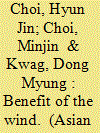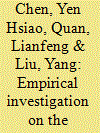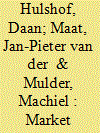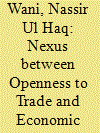|
|
|
Sort Order |
|
|
|
Items / Page
|
|
|
|
|
|
|
| Srl | Item |
| 1 |
ID:
186805


|
|
|
|
|
| Summary/Abstract |
The "rally-'round-the-flag effect" sparked by North Korea (the so-called 'Northern Wind') has been an important part of South Korean domestic politics. Despite the long history and controversy associated with politics of Northern Wind, the literature provides surprisingly little quantitative evidence on this phenomenon. In this study, we empirically investigate the relationship between North Korean-induced incidents and former President Park Geun-hye's weekly job approval ratings. Using vector autoregressions, we find that (1) President Park gained political benefits from North Korea, where negative events (e.g., armed attacks) generated a larger boost in approval than positive events (e.g., high-level talks); (2) rally effects varied across regions according to different perceptions of the North Korean regime: during security crisis, Park received the largest rallies in Gyeongnam province where the dominant image of North Korea was an 'enemy that threatens our safety'; and (3) a test of nuclear weapons or intercontinental ballistic missiles (ICBMs) did not affect approval ratings even though it captured widespread media attention.
|
|
|
|
|
|
|
|
|
|
|
|
|
|
|
|
| 2 |
ID:
124546


|
|
|
|
|
| Publication |
2013.
|
| Summary/Abstract |
This paper employs a structural time series model designed with three components of stochastic seasonality, trigonometric expression of cyclicality and local linear trend to investigate the evolutionary process of China's GDP. In particular, the model is able to detect the stop-go feature of China's economic growth, i.e., growth cycle, as well as business cycle. The empirical result suggests that most variation in China's macroeconomic performance came from business cycle. The investigation of the three components along with historical events suggests that the Chinese economy had been largely influenced by political activities up to the early 1990s. In the mid-1990s China entered a period of stable and highly growing economy, thanks to the economic reform and the successful implementation of macroeconomic policies. However, since the mid-2000s China has become more sensitive to the turbulences in international markets. In the foreseeable future, the challenge facing China is a more volatile economy with possible slowdown in the economic growth, although the growth rate would still be high compared to developed economies.
|
|
|
|
|
|
|
|
|
|
|
|
|
|
|
|
| 3 |
ID:
176824


|
|
|
|
|
| Summary/Abstract |
Understanding the Granger causality directions between electricity production (EP) and Gross Domestic Product (GDP) is helpful for policymakers in order to design, redesign, and implement effective energy policies. Although there are plenty of studies on this issue, no consistent conclusion about said relationship exists. In this paper, we provide an updated analysis for the case of Mexico in the context of the design and implementation of a new energy policy. We employ three tests, 2 linear and one nonlinear, and find no evidence of causal relation, in a Granger sense, between EP and GDP for the 1965–2018 period. Our results suggest that Mexican policymakers should consider enriching the bill by further designing policies that directly seek to promote a self-sufficient electricity sector by enhancing generation output by private actors and transmission capacity.
|
|
|
|
|
|
|
|
|
|
|
|
|
|
|
|
| 4 |
ID:
150622


|
|
|
|
|
| Summary/Abstract |
After the liberalisation of the gas industry, trading hubs have emerged in Europe. Although these hubs appear to be liquid market places fostering gas-to-gas competition, the efficiency of the gas market remains a topic of interest as a fair share of gas is still traded through long-term contracts with prices linked to the oil price while the number of gas suppliers to the European market is limited. In order to assess the efficiency of the gas market, we analyse the day-ahead spot price at the Dutch gas hub over the period 2011–2014. We find that the oil price had a small positive impact on the gas price. Changes in the concentration on the supply side did not affect the movement in gas prices. The availability of gas in storages and the outside temperature negatively influenced the gas price. We also find that the gas price was related to the production of wind electricity. Overall, we conclude that the day-ahead gas prices are predominantly determined by gas-market fundamentals. Policies to further integrate gas markets within Europe may extend this gas-to-gas competition to a larger region.
|
|
|
|
|
|
|
|
|
|
|
|
|
|
|
|
| 5 |
ID:
168504


|
|
|
|
|
| Summary/Abstract |
The notion that the international trade is the foundation of economic growth dates long back, and even now, an irresistible body of literature confirms a strong and positive link between trade openness and economic growth. However, most of these studies are focused on developed countries. Indeed literature from developing countries are scant, those from under developed and a landlocked country like Afghanistan are almost non-existent. This article endeavours to innovatively scrutinize the relationship between trade liberalization and economic growth in Afghanistan, using biannual data for the period 1995–2016 and thus evaluates the comparative effect of three different measures of trade openness on the economic growth by using more rigorous econometric techniques. Autoregressive distributed lag (ARDL) method, JJ CO-integration and ordinary least square (OLS) results suggest significant positive long-run relationship between export and economic growth. In contrast, total volume of trade and imports have significant negative effect on the economic growth. The addition of variables and results of fully modified OLS suggest that the results are robust. The Granger causality and variance decomposition analysis indicate the unidirectional causality between trade openness and economic growth. In export model, causality runs from export to growth. Whereas, in the model with total volume of trade and import, causality runs from growth to total volume of trade and imports in Afghanistan. From the findings, it is concluded that the policymakers should focus on export promotion strategy to enhance the economic growth in Afghanistan. Besides, efficient utilization of capital goods should be ensured and reliance on non-capital goods should be less in order to ensure high domestic production in the country.
|
|
|
|
|
|
|
|
|
|
|
|
|
|
|
|
|
|
|
|
|